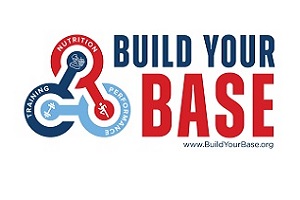Project Triple Jump: Bounding ahead into 2013-14
Note: Camp photos are from NSAF files, primarily from 2011 edition before current campers started.
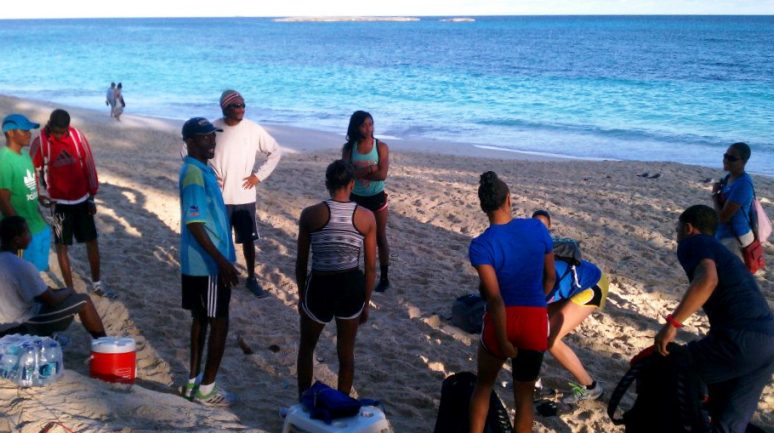
Performance Triple Jump campers on the beach in 2011.
Addition of Coach Jones and 2 domestic clinics provides boost
Hard results. There are various ways to evaluate the success of things like in-depth clinics or comprehensive training programs, but nothing beats improvement measured by hard results. And let there be no doubt, athletes who completed the second National Scholastic Athletics Foundation’s Performance Triple Jump Camp last November in Nassau, The Bahamas, improved and got some serious results in the spring and summer of 2013.
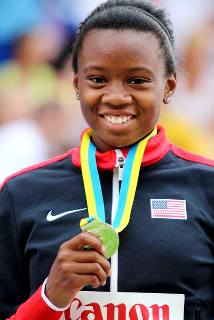
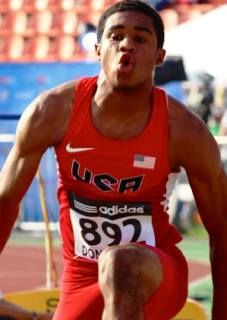 Results like Keturah Orji’s mind-boggling 44-11 bronze-medal triple jump in the World Youth Championships in July (photo at far right). As a Mt. Olive (Flanders, N.J.) HS junior, Orji first became a national champion in March at New Balance Nationals Indoor (41-0.25), but that was only the beginning. She was more than two feet better (43-9.25) by the time she captured the NBN Outdoor title in June, and then became history’s second-best prep ever a month later in Donetsk.
Results like Keturah Orji’s mind-boggling 44-11 bronze-medal triple jump in the World Youth Championships in July (photo at far right). As a Mt. Olive (Flanders, N.J.) HS junior, Orji first became a national champion in March at New Balance Nationals Indoor (41-0.25), but that was only the beginning. She was more than two feet better (43-9.25) by the time she captured the NBN Outdoor title in June, and then became history’s second-best prep ever a month later in Donetsk.
Results like KeAndre Bates’ 51-6.25 on the boys’ side of those same Worlds in Donetsk – leading all qualifiers into the final (photo at near right). His junior season for Burges (El Paso, Texas) HS, following the Bahamas trip, was detoured a bit by health issues. He still won the Texas Relays, was 3rd at 4A state, but then really started breaking out when he got over 50 feet at Great Southwest. With his 2nd-best-ever effort of 50-8.25, he was 9th in the WY final.
And results like Felicienne Axel’s 40-1.5 to win the Texas 3A state meet. Axel’s not quite at the World finalist level yet, but then she also just completed her sophomore year at Columbus (Texas). Her 40-11.25nwi was the best all-conditions jump by a 10th-grader in 2013.
Orji, Bates and Axel are three of the eight athletes who attended the Bahamas camp last year, joining the six who participated in the inaugural 2011 camp.
The results for this project’s athletes could be even better in 2014 and beyond – and not just because all three of the above-mentioned athletes will return. Why? Three big reasons: Two domestic fall clinics that have been added to the project – which will lead into the Bahamas camp, which moves from the late fall into March – and one excited new coach. That coach is Macka Jones, a longtime devotee of the triple jump who first traveled to the Bahamas last fall to work with the athletes and Coach Peter Pratt – the Bahamas national coach who leads the program there. Jones is now the Project Coordinator and, under his leadership, the two domestic clinics are planned for November and December (probably the first one in the Dallas area and the second in Florida). These will create a much greater opportunity for both ongoing development of the selected elites and for broader participation of athletes and coaches.
“As we get these new clinics off the ground, I think this can turn into something even bigger,” says Coach Jones.
A total of $111,000 has been budgeted by the NSAF for the project so far: $14K for 2011 and $19K for 2012, with the late fall trips to Nassau; $28K for fiscal year 2013 (which includes just the two domestic clinics); and $50K for 2014 (which includes the March Nassau trip and the Fall 2014 domestic clinics).
That brings us to the origin of this project: The triple jump and the javelin were the targets when the NSAF’s Jim Spier and Joy Kamani two years ago began musing over events where Americans were struggling internationally. The javelin was clearly one of those events, what with the last Team USA Olympic medals won in the event coming in 1972 (men) and 1976 (women) – and none in the World Champs. The Kultan Keihas Project was the result there, with the project’s students two months ago making the third trip to Finland.
The triple jump may not seem like it falls in that same category of the weaker U.S. events, what with Christian Taylor and Will Claye having netted a gold-silver finish for Team USA in the London Olympics last year. But beyond the success of those two – both from Coach Mike Holloway’s program at Florida – the depth hasn’t been there. Before they came along, there had been an unprecedented 3-year drought of U.S. men in the top 10 world rankings. And on the women’s side, there have been no American Olympic or WC medalists – ever – in 16 combined championships. Similarly, there has never been a U.S. woman on the World Junior medal stand and just one U.S. male since 1998 (Omar Craddock in 2010).
So Project Triple Jump was born – and if you take kids to Finland for the javelin, then for the triple jump you take them to ... The Bahamas. The success that athletes from the small Caribbean nation have enjoyed might not be quite as legendary as what the Finns have done in the javelin, but there have no doubt been significant triple jump achievements.
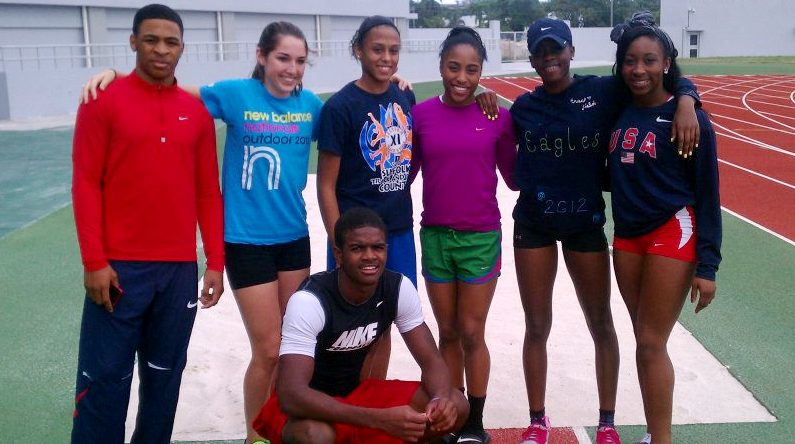
Performance Triple Jump campers on the track in 2011.
Much of the Bahamian success can be attributed to Coach Pratt, who’s been coaching the event for more than 30 years and has headed up the teaching at the camp. He is a former Bahamian triple jump champion himself, winner of the inaugural CARIFTA Games, NCAA Champion and current Bahamian National Team coach. He is an IAAF Level V Diploma Elite Coach for Horizontal Jumps and currently coaches Jumper's INC.
The many elite TJ’ers Coach Pratt has developed – medalists at every level of the sport – most recently include the Minns twins, who won gold and bronze medals at the 2011 World Youth Champs before Latario Collie-Minns took World Junior bronze in 2012. Coach Pratt also served as National Jumps Coach for Kingdom of Saudi Arabia for three years.
So how did Coach Macka Jones – now a teacher and volunteer coach at Cedar Hill HS near Dallas – get in the picture? Well, while in El Paso (primarily El Dorado HS and Texas Heat TC) over a 10-year period, Jones – a long-time devotee of the triple jump – had developed some outstanding talent himself. With the Heat, Jones and partner coach David Pearson coached Bates and Felix Obi. There was Obi made the World Junior team as a Franklin HS senior in 2012 (51-5.75 seasonal best), then medaled in the Pan Am Juniors a few weeks ago after his frosh year at Baylor. Bates was a 49-6.5 jumper as a soph in 2012 before getting involved with the clinics. And Jones also worked with Axel, who went 38-6 even before starting high school in 2011.
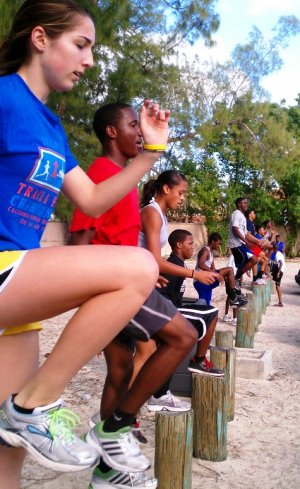
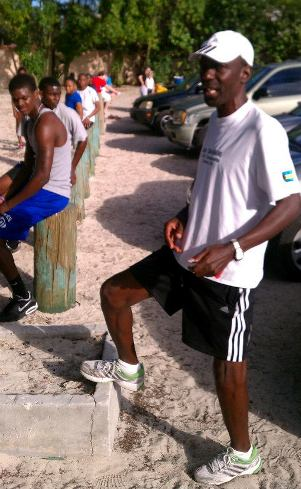 Jones wanted to find ways to help his athletes gain opportunities and exposure. Through a coach he knew at Kansas State, he was connected to the NSAF’s late Cedric Walker. Walker helped get Jones’ athletes into the program, and then suggested that the coach himself come along last November to the Bahamas.
Jones wanted to find ways to help his athletes gain opportunities and exposure. Through a coach he knew at Kansas State, he was connected to the NSAF’s late Cedric Walker. Walker helped get Jones’ athletes into the program, and then suggested that the coach himself come along last November to the Bahamas.
(photos: Coach Pratt demonstrates technique for a creative "parking lot posts" drill at right, while athletes execute during the 2011 camp at left)
Having heard Coach Pratt before at a symposium in 2008, Jones jumped at the chance to learn from this triple jump guru. “We agreed that if I could go, I could take back with me the things that my athletes were taught and continue to reinforce them.”
Jones remembers back when he was first introduced to the triple jump as an 8th-grader. “I couldn’t do it and I said, ‘This is stupid,’ and walked away.” But it wasn’t too long before he began to appreciate the intricacy of the event and what it requires of the athlete. “If you have innate ability, strength and speed, you can translate that relatively into the long jump,” he says. “Of course, the triple jump is different. You need the rhythm and timing to translate that speed through three jumps, maintaining your balance and handling your body weight. It’s not so easy.”
Like the student-athletes in attendance, Jones was enchanted by what he discovered in The Bahamas as he learned new concepts from Coach Pratt, noting how he had created an “environment” for learning, an environment fostering passion for and success in the triple jump that almost defied explanation. “I wasn’t used to seeing that.”
That was something Felicienne Axel noticed, too, the way her favorite event was regarded there. “I really did,” she said. “It seems like everyone is interested in it. Sometimes I don’t think the triple jump is very much appreciated (where I come from).”
Specifically, Coach Jones noticed the Pratt-coached Bahamian athletes who also were part of the camp “had an amazing grasp on the technical aspects of the event, while being just as explosive as other athletes I’ve seen. And they were doing it with weight training that utilized only their own body weight. That was amazing, that they could be as strong and explosive without heavy loading.”
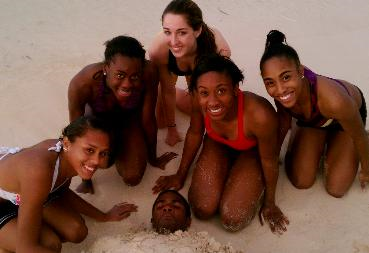 Success is also in the details. Axel remembers Coach Pratt “always saying ‘don’t go to the ground (runway), let it come to you ... and always hold your legs up.” Orji recalls learning “to use our peripheral vision while jumping, to keep your weight/body over your feet – in essence maintaining balance – and being able to do everything from a short approach.” Bates said both the classroom approach and the workouts benefitted him.
Success is also in the details. Axel remembers Coach Pratt “always saying ‘don’t go to the ground (runway), let it come to you ... and always hold your legs up.” Orji recalls learning “to use our peripheral vision while jumping, to keep your weight/body over your feet – in essence maintaining balance – and being able to do everything from a short approach.” Bates said both the classroom approach and the workouts benefitted him.
(Photo at left: The 2011 campers enjoy some play time in the sand.)
Being around the exceptional native triple jump students, as well as some of your own outstanding teammates, can be a bit daunting at first. Orji was “honored and excited” to be invited, but “also quite nervous because I wasn't sure what to expect. It was really intimidating at first, because almost everyone was better than me and seemed to have it together.”
For the American youngsters, the trip comes with a great deal of focus and purpose. Carla Forbes, in a blog she kept during the 2011 camp, recalled an initial team meeting “to discuss why the six of us were chosen to be here ... we talked about the lack of US female triple jumpers on the medal stand, and how this program is aspiring to change that.”
Eventually, intimidation turns to determination. “It was really motivating watching other athletes jump further than me,” says Orji. “I have a competitive nature, so I really wanted to be like them some day. I really committed myself to applying the new skills that I learned in addition to what my coaches were telling/teaching me.”
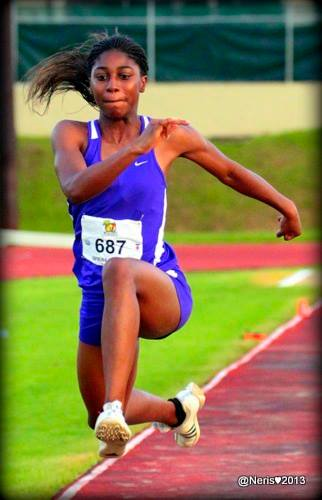 Coach Jones has observed how athletes in many other countries, particularly the Caribbean and European nations that have been successful in the TJ, become committed to the event from an early age.
Coach Jones has observed how athletes in many other countries, particularly the Caribbean and European nations that have been successful in the TJ, become committed to the event from an early age.
(photo at right: Darrielle McQueen, new Project participant for 2013-14, jumping at 2013 CSI)
“You can’t just jump into it for a few years, and then walk away,” he says. “You see these kids and by the time they become elite-level athletes, they’re really trained in the nuances of the event. They have that jump on us.
“We have to train along the same lines. These clinics are really a step in the right direction. To get to places we want to go, our kids have to be exposed to these events at an early age. That’s why I think this project will work.”
Having the additional clinics in Texas means that the project won’t be just a once-a-year thing for four days or so, but rather a learning process extended over several months between three experiences. The athletes know there will be a difference. Orji is looking forward to “observing others and learning more technical related skills that are personal to my style. I know that there are several areas that still need work.”
Axel knows she’ll have to be on the ball and stay on the ball. “Coach Macka can really, really keep on me now about my training,” she says with a laugh. She knows her own mother, a 40-foot TJ’er herself in high school, will lend a hand as well.
“We get to retain jumping technique with the multiple camps that we’re going to and, hopefully, we will get better because of it,” says Bates.
The project will welcome a lot of new faces this fall. The first to be invited for the entire series was Darrielle McQueen, who just started her senior year at North Florida Christian. She won the Florida 1A title last spring, as well as the Golden South Invite, then was invited to the Caribbean Scholastic Invite where she leapt a PR 40-9.5 – a PR, that is, until she went 40-11 to win the USATF JOs.
McQueen calls her CSI opportunity “an awesome experience” and is “very excited” about Project Triple Jump. “I really want to perfect the craft,” she says, “to better learn proper technique, holding my phases and getting the maximum out of each phase.”
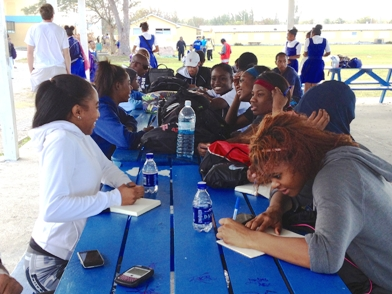 An announcement will be published later this week regarding four more athletes invited for all three clinics/camps. And – as is the case with the North Carolina clinics in the javelin project – there will be opportunities for additional athletes and coaches to come to Dallas to absorb what’s offered there.
An announcement will be published later this week regarding four more athletes invited for all three clinics/camps. And – as is the case with the North Carolina clinics in the javelin project – there will be opportunities for additional athletes and coaches to come to Dallas to absorb what’s offered there.
(photo at left: Campers from 2012 journaling between sessions.)
The great things about kids being in this program multiple years, starting young and continuing on to their senior years, is that they begin to accumulate wisdom which they can themselves impart to the younger athletes. When asked what guidance she might give at this point, Orji’s response well sums up much of what Project Triple Jump aspires to teach.
“You have to be motivated. You can't let other things distract you. You can't get discouraged if things aren't always going the way you expect,” she says. “Sometimes when you are working on new things, you may go a few steps back in order to go many steps forward. Learning is a process and it all takes time. If you keep at it, and stayed focused on your goals, you can accomplish anything you put your mind into.”

